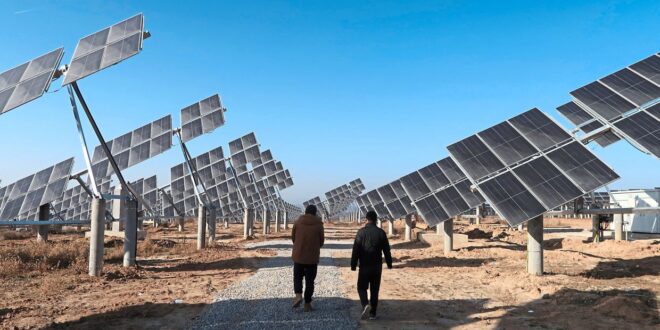WHEN you introduce a raft of tariffs and restrictions to protect domestic industries, you’d better make sure there are some around to protect. That’s a major problem with the US decision to treat China’s clean technology leadership as grounds for a trade fight.
If local factories are getting off the ground but struggling with international competition, then the damage done by border duties might be justified as the cost of supporting homegrown startups.
When investors are already giving up on domestic production, however, then tariffs serve no other purpose but to raise costs for consumers.
Such imposts aren’t just a barrier on the road to net-zero: they’re also a willful act of economic self-harm.
US politicians currently touting the damage from Chinese solar panels and electric vehicles (EVs) ought to be giving a lot more thought to how many components of a domestic clean energy supply chain are withering right now.
The very genuine competitive threat out of Asia is just one of multifarious cause, ranging from corporate timidity, to a lack of government support, to bureaucracy and red tape, to an absence of clear targets.
The lesson, however, should be clear: If you want to do green industrial policy, you need to really commit to it.
Right now, America is neglecting the bits that could make it a future clean-tech superpower, and focusing on battles that it’s already lost.
Winners and losers
Early-stage technologies like hydrogen and geothermal are missing out on federal loan funds for clean energy
Take steel. President Joe Biden last week promised to triple tariffs on imports from China, and has promised to block Nippon Steel Corp’s US$14bil acquisition of United States Steel Corp.
The metal is a perennial symbol of a country’s industrial might, but it’s also responsible for about 7% of the world’s carbon emissions.
Remarkably little is being done to address this.
“The transition to greener steel production in the United States has stalled in comparison to European competitors,” the Roosevelt Institute, a progressive think tank, wrote in a report last month.
“US steelmakers have at best planned minimal investments in marginal emissions reductions.”
In spite of looming levies on US-produced steel from the European Union’s carbon border adjustment mechanism, little is being done to address this.
Cleveland-Cliffs Inc, which lost out in the battle for US Steel, will dedicate the unused takeover cash to as much as US$600mil of share buybacks, chief executive officer Lourenco Goncalves said in December.
That’s twice what a coalition of Swedish companies are spending building Europe’s first green steel plant, the Roosevelt Institute wrote.
Or consider the case of Hexcel Corp. The Stamford, Connecticut-based company was one of the pioneers in carbon fiber, whose light weight and impressive strength make it essential for the ever-larger wind turbine blades that are becoming standard.
The US wind sector faces looming supply bottlenecks for carbon fiber, but Hexcel last year closed down its only US plant dedicated to turbine-makers.
The “wind energy industry remains challenged,” chairman Nick Stanage told investors last October. In future, it will only be serviced by a Hexcel plant in Austria.
Out of charge
The market capitalisation of lithium-ion battery maker Microvast has dwindled. Microvast Holdings Inc, the lithium-ion battery business that spent US$11mil buying Hexcel’s Colorado factory, hasn’t performed much better.
The company has lost about two-thirds of its value after the US Department of Energy cancelled a US$200mil loan to the business last May, intended to fund a cell plant in Tennessee with General Motors Co as customer.
Republican senator John Barrasso had complained that Microvast’s existing plant west of Shanghai meant that the loan would be a “danger to our national security.”
As a result, capacity to produce up to eight gigawatt-hours annually of lithium-ion batteries in the United States is on hold, unless alternative financing can be secured.
The Chinese plant, meanwhile, is currently ramping up from 5GWh toward an eventual 12GWh of yearly output.
It’s certainly true that China has built up an impressive lead in a range of clean technologies, particularly solar panels and EVs.
But those only represent a small part of the energy revolution that’s going to be required over the coming decades as the world decarbonises.
Set up a carbon-free grid and get rid of every petrol-powered vehicle on the roads, and you’ve still only eliminated about half of US emissions. The technologies to fix the remainder are barely being explored.
Half of the problem
Fossil-fired electricity and gasoline only make up about 51% of US emissions
Funding early-stage industry has been the purpose of such protections in the United States all the way back to founding father Alexander Hamilton, according to Inu Manak, a fellow at the Council on Foreign Relations, a Washington-based think tank.
“If we subsidise, it shouldn’t go to the industries that are long established,” she said.
“You shouldn’t have tariff protections, because you’re limiting the ability of your own market to become competitive.”
That suggests a fruitful path out of the current trade impasse. It may be challenging to assail China’s lead in some of the clean technologies that have emerged over the past 15 years – but the field is wide open for those that are yet to get established.
The loan programme office, the US$500bil US government fund dedicated to transformative green power projects, has so far financed a total of just US$1.6bil in geothermal, hydrogen, biofuels, and energy storage – not much more than the US$1.04bil that’s gone to a single plant in Nebraska to make carbon black for car tires from natural gas.If America wants to win the coming industrial revolution in clean energy, protections for incumbent industries won’t cut it. Sooner or later, it’s going to need to invest in the future. — Bloomberg
David Fickling is a Bloomberg Opinion columnist covering climate change and energy. The views expressed here are the writer’s own.
 BeritaKini.biz Berita Viral Terkini di Malaysia
BeritaKini.biz Berita Viral Terkini di Malaysia





